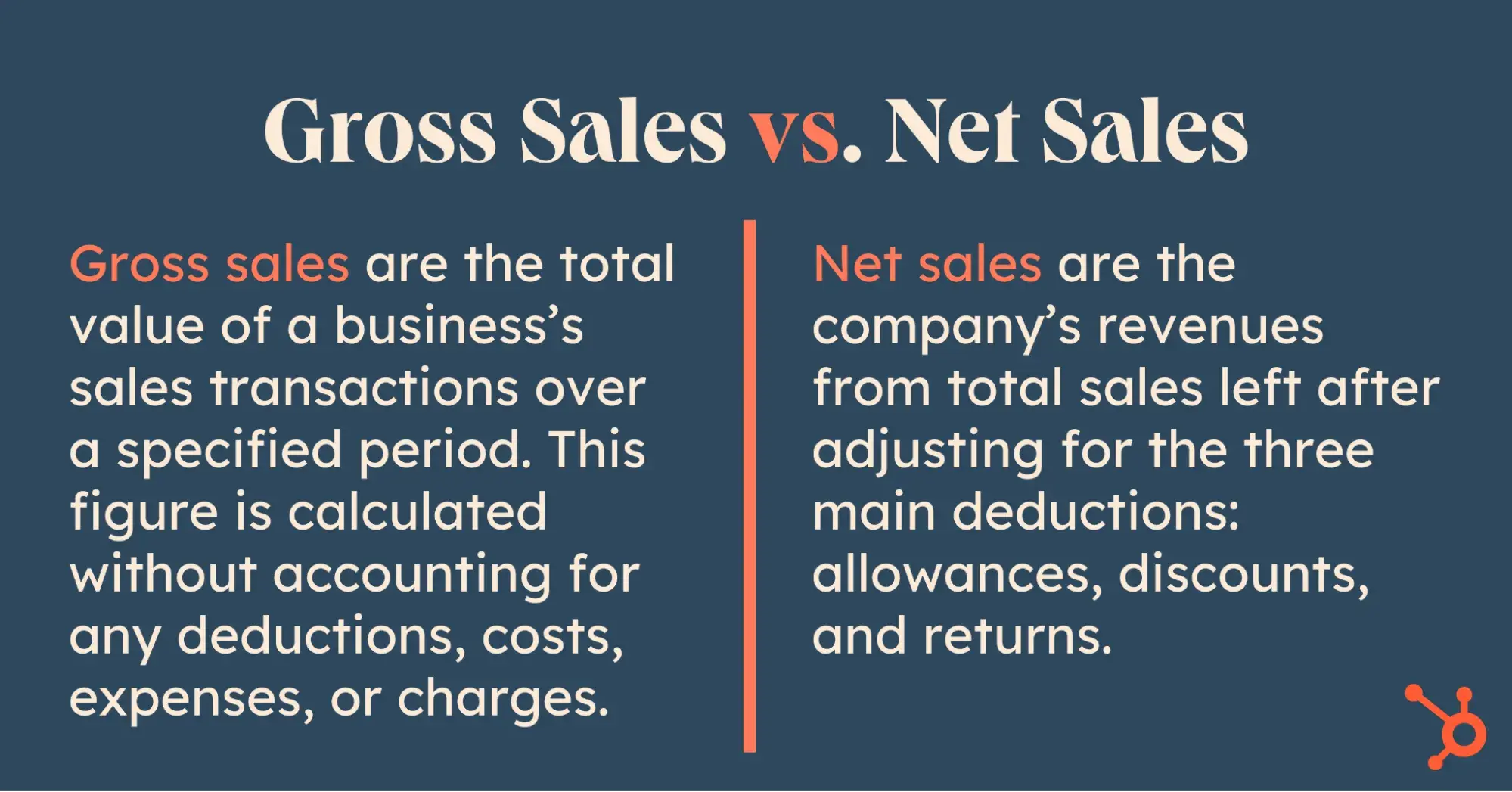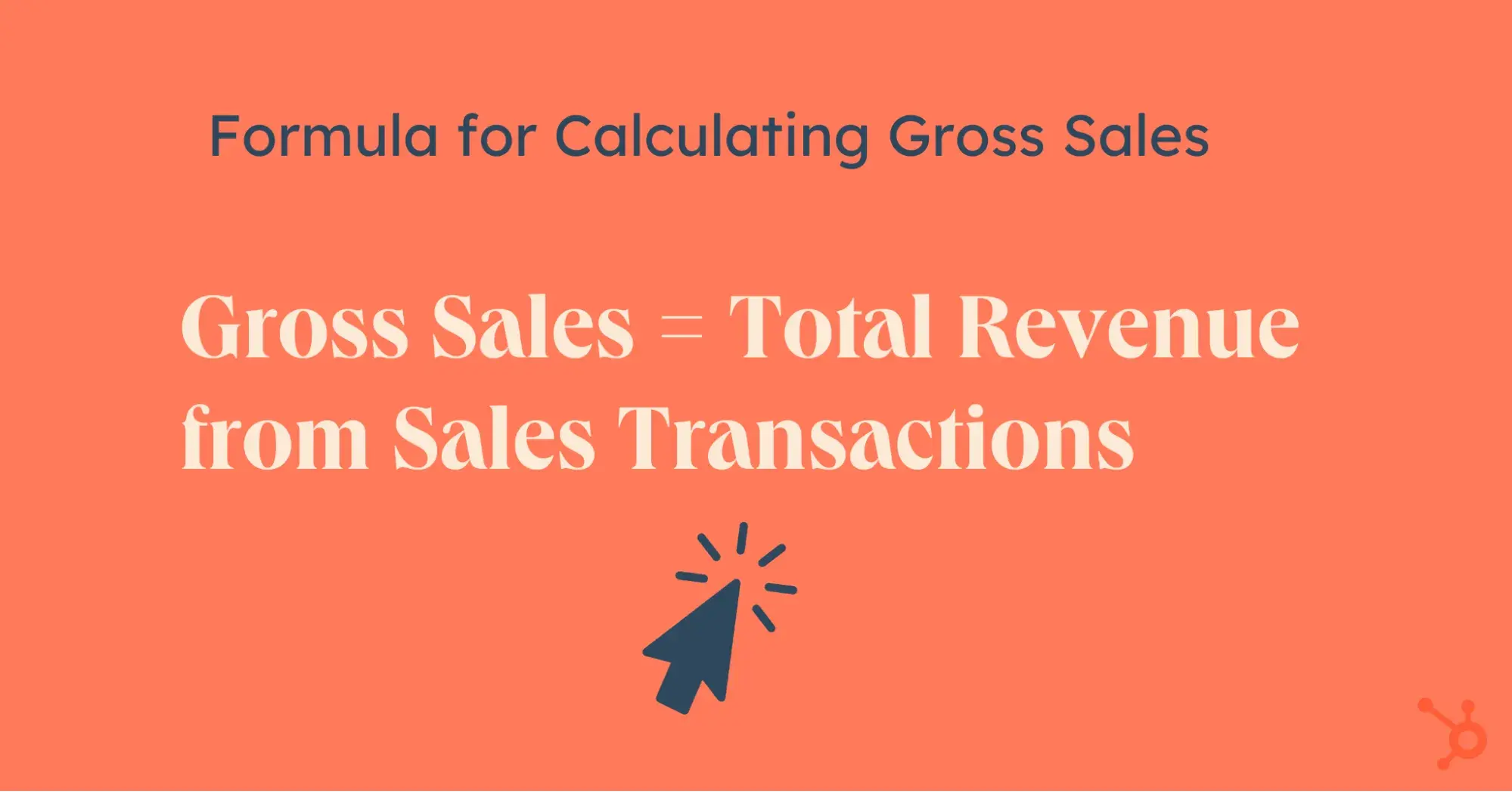My “aha” moment came when I realized that gross sales represent the total revenue from all sales (before any adjustments are made). In contrast, net sales strip away some aspects to give a more accurate picture of what’s coming into the business. Once this clicked, I saw how these metrics can tell very different stories about my small business’s performance and which one to use when.
Table of Contents
- Gross Sales vs. Net Sales
- How to Calculate Gross Sales
- How to Calculate Net Sales
- The Difference Between Gross and Net Sales + What They Can Tell You
- So, which one should you calculate?
Gross Sales vs. Net Sales
Gross sales are the value of all of a business’s sales transactions over a specified period of time without accounting for any deductions. Net sales are a company’s gross sales minus three kinds of deductions: allowances, discounts, and returns.
In simpler terms, gross sales are the raw sales figures, while net sales are the net take-home revenue. Let me explain their difference better by highlighting their definitions.
What are gross sales?
Gross sales are the total value of a business’s sales transactions over a specified period. This figure is calculated without accounting for any deductions, costs, expenses, or charges.
What are net sales?
Net sales are the company’s revenues from total sales left after adjusting for the three main deductions: allowances, discounts, and returns.

Let me take you over what these deductions mean.
Allowances
When customers purchase a product with a minor yet noticeable defect, they sometimes contact the seller. They may enter into an arrangement where they do not return the product but get a discount from the seller while keeping it. This is known as an allowance.
Businesses extend allowances to prevent buyers from returning the product or losing loyalty. When they do so, they deduct the difference between the original and discounted prices when assessing their business’s overall standing. In accounting, this partial refund is subtracted from the gross sales figure when calculating net sales.
Let me explain with an example. Assume I’ve sold twelve coffee mugs for $20 each. My customer complains that three of them have minor defects. As a business owner, I may offer them an allowance of $5 for each defective mug to compensate for the defect and get them to keep the product. In that case, I’ll return them $45 ($15x3), and they won’t return the product. My net sales would reflect this $45 partial refund deduction, but my gross sales wouldn't.
Discounts
Sales discounts are price reductions that sellers offer a buyer for immediate or early payment. I’ve found that most businesses generally take this approach when they urgently need cash.
For instance, I remember being offered a 2% discount to pay off a supplier invoice within ten days of receiving it, as against their standard payment terms of 30 days. I’d ordered supplies worth $10,000, and the company offered me a 2% discount. So, I paid them $9,800 within ten days to get the discount. In this case, the supplier would deduct the $200 discount from their gross sales when calculating their net sales. In other words, their net sales would reflect the discount, but gross sales wouldn’t.
Returns
Sales returns occur when a buyer returns a product to a seller and asks for a complete refund. Buyers return goods for reasons like defects in the goods ordered, late shipping, incorrectly shipped items, incorrect product specifications, or excessive quantities ordered or shipped and get credited back with the full amount they’ve paid. When this happens, sellers deduct the sum of refunds from their gross sales to obtain a more accurate picture of their business performance. This is reflected in their net sales number.
The most straightforward (and relatable) example I can give is ecommerce returns. You, as a buyer, ship back the product to the seller. Once they verify it, they credit your account back with the amount you paid for the product.
Now that we’re familiar with gross and net sales concepts, let’s examine how to calculate them.
How to Calculate Gross Sales
Calculating gross sales is pretty straightforward. You simply need to add up all sales transactions without applying any deductions. I’ve figured this is as straightforward as multiplying the units sold by the price per unit.
Formula for Calculating Gross Sales
Gross Sales = Total Revenue from Sales Transactions

Let me walk you through an example of gross sales calculation.
Example: Gross Sales Calculation
Imagine a dropshipping business selling customized tees. Suppose this business sells 100 tees at $200 each in a particular month. Their gross sales sales in that month would be:
100 tees × $200 = $20,000
As you can see, I’ve simply multiplied the number of units sold by the price per unit to calculate gross sales. I haven’t subtracted any discounts, returns, or allowances yet; these would come in when calculating net sales.
How to Calculate Net Sales
Calculating net sales requires first calculating gross sales. You start with the gross sales number and then adjust it with deductions, returns, discounts, and allowances to reflect your actual revenue.
Formula for Calculating Net Sales
Net Sales = Gross Sales - (Returns + Discounts + Allowances)

To explain this better, let me revisit the customized tee business example I’ve used in the gross sales calculation.
Example: Net Sales Calculation
Let’s assume the business had:
- $10,000 in returns (50 tees returned at $200 each).
- They offered $500 in promotional discounts.
- They provided $200 in allowances for tees with minor defects.
Here’s how I’ll reach their net sale from their gross sales:
$20,000 (Gross Sales) − $10,000 (Returns) − $500 (Discount) − $200 (Allowance) = $9,300 (Net Sales)
Thus, their monthly net sales are $9,300. This figure accurately represents the revenue they can retain from their operations.
I’m guessing with these gross and net sales calculations, you’ve already figured out that they are related but distinct concepts. Let me go over their main differences in detail.
The Difference Between Gross and Net Sales + What They Can Tell You
Gross sales is a broader concept. Net sales are its subset. Without any deductions, the gross sales reflect the overall business performance. However, net sales reflect the specific financial position of business operations.
As a result of showcasing the bird’s eye view picture of operations, gross sales are usually used to assess marketing and sales goals. Since net sales get into the finer details of what you retain, they are used to report on financial matters.
I’ve tabulated these key differences in gross vs. net sales below for better clarity:
|
Criteria |
Gross Sales |
Net Sales |
|
Concept |
Reflects the total revenue generated. |
Reflects actual revenue left after accounting for relevant deductions. |
|
Formula |
Gross Sales = Total Revenue from Sales Transactions |
Net Sales = Gross Sales - (Returns + Discounts + Allowances) |
|
Purpose for Calculation |
Understanding the overall sales performance. |
Getting a clearer view of financial health. |
|
Usage/Application |
Assessing marketing and sales goals. |
Financial reporting and profitability analysis. |
Let me revisit the customized tee example to illustrate the gross vs. net sales differences better.
Example: The Difference Between Gross and Net Sales
Quick recap: For the concerned company, we had the following figures.
- Gross Sales: $20,000
- Net Sales: $9,300, after accounting for Returns ($10,000), Discounts ($500) and Allowances ($200)
Their gross sales of $20,000 show that the products are popular. However, their net sales vary sharply at $9,300. This reveals gaps and how their actual take-home after-sales differs significantly. Yet, both numbers are significant.
Gross sales provide insights into how well the business’s promotional campaigns, pricing strategies, and sales team are performing to drive sales. They’re also useful for benchmarking against competitors and identifying growth patterns over time.
In contrast, net sales are more useful for profitability analysis.
When there’s a significant gap between gross and net sales, it signals that there could be high return rates, excessive discounts, or product quality concerns to address. In our example here, net sales are less than half of gross sales, indicating potential concerns with the product or service quality.
So, which one should you calculate?
Answer: Both.
I’ve learned that gross and net sales are both critical to understanding, calculating, and assessing business performance. In fact, studying them together explains how well the business approaches its sales efforts — and also how efficiently the core business performs. A noteworthy gap between these numbers demonstrates the need to examine product quality.
I hope this research helps you assess your business performance, craft the right strategies, and grow. Happy accounting!
Business Acumen





![Business Ethics — Why They Matter and How Your Company Can Get it Right [+Expert Tips]](https://53.fs1.hubspotusercontent-na1.net/hubfs/53/business-ethics-1-20250224-5750570.webp)






